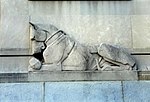Lee Lawrie

Lee Oscar Lawrie (October 16, 1877 - January 23, 1963) was one of America's foremost architectural sculptors and a key figure in the American art scene preceding World War II. His work includes the details on the Capitol building in Lincoln, Nebraska and building details and the Atlas sculpture at New York City's Rockefeller Center.
He was born in Rixdorf, Germany, and came to the United States, as a young child, in 1882, settling in Chicago. It was there, at the age of 14, that he began working for a sculptor named Richard Henry Park. In 1892 he had the chance to work for many of the sculptors in Chicago, constructing the "White City" for the Columbian Exposition of 1893. Following the completion of the work at the Expo, Lawrie followed the other mostly East Coast artists back east and settled in as an assistant to William Ordway Partridge. The next decade found him working with other established sculptors, St. Gaudens, Martiny, Proctor, Kitson and others. His work at the St. Louis Exposition under Karl Bitter, the foremost architectural sculpture of the time, allowed Lawrie to further develop both his skills and his reputation as an architectural sculptor.

It was Lawrie's collaborations with Ralph Adams Cram and Bertram Goodhue that brought him to the forefront of architectural sculptors in America. For them, he produced sculpture for the Chapel at West Point, Church of St. Vincent Ferrer, St. Bartholomew's Church, and the reredos at St. Thomas, the latter three being in New York City. After the breakup of the Cram, Goodhue firm, Lawrie continued to work with Goodhue (and his successors, after Goodhue's death in 1924) on the Nebraska State Capitol, the Los Angeles Public Library, the Rockefeller Chapel at the University of Chicago, the National Academy of Sciences Building in Washington, D.C. and Christ Church Cranbrook, in Bloomfield Hills, Michigan.
Other important commissions can be found at the Rockefeller Center in New York City, the Education Building in Harrisburg, Pennsylvania, the Louisiana Capitol Building in Baton Rouge, Louisiana, the Peace Memorial at Gettysburg, Pennsylvania, the Fidelity Mutual Life Building in Philadelphia, Pennsylvania, the Ramsey County Courthouse in Saint Paul, Minnesota, and the National Shrine of the Immaculate Conception and Library of Congress Annex, both in Washington, D.C.

In addition to these, Lawrie executed sculptures for at least three towers. The Harkness Memorial Tower at Yale University, New Haven, Connecticut, the Beaumont Memorial Tower at Michigan State University in East Lansing, Michigan, and the Bok Singing Tower in Mountain Lake, Florida. Paradoxically, Lawrie's most recognizable work is not architectural. It is the Atlas figure on Fifth Avenue at Rockefeller Center in New York City.
Over his long career his style evolved through Modern Gothic, to Beaux-Arts Classicism and finally into Moderne or Art Deco.
More pictures of the work of Lee Lawrie
 | |||
 |
 |
 | |
 |
 |
 |
References
- Bok, Edward W., America's Taj Mahal - The Singing Tower of Florida, The Georgia Marble Company, Tate, Georgia c. 1929
- Brown, Elinor L., Architectural Wonder of the World, State of Nebraska, Building Division, Lincoln, Nebraska 1978
- Fowler, Charles F., Building a Landmark - The Capitol of Nebraska, Nebraska State Building Division, 1981
- Garvey, Timothy Joseph, Lee Lawrie Classicism and American Culture, 1919 - 1954, PhD. Thesis University of Minnesota 1980
- Gebhard, David, The National Trust Guide to Art Deco in America, John Wiley & Sons, NY, NY 1996
- Kvaran, Einar Einarsson, Architectural Sculpture of America, unpublished manuscript
- Lawrie; Lee, Sculpture - 48 Plates With a Forward by the Sculptor" J.H. Hanson Cleveland, Ohio 1936*Luebke, Frederick C. Editor, A Harmony of the Arts – The Nebraska State Capitol, University of Nebraska Press, Lincoln, Nebraska 1990
- Oliver, Richard, Bertram Grosvenor Goodhue, The Architectural History Foundation, New York & The MIT Press, Cambridge, Massachusetts 1985
- Whitaker, Charles Harris, Text by Lee Lawrie et al Editor Bertram Grosvenor Goodhue, Architect-and Master of Many Arts, Press of the American Institute of Architects, Inc., NYC 1925
- Whitaker, Charles Harris and Hartley Burr Alexander, The Architectural Sculpture of the State Capitol at Lincoln Nebraska, Press of the American Institute of Architects, NY 1926
